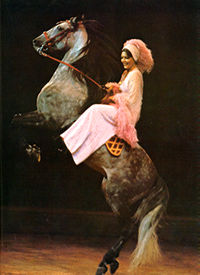
Circus

Man has trained many of his domestic animals to perform for him. As
with all animal training, the fanciful tricks of performing horses are based on
the equine leaps and bounds that come naturally to all horses.
In Love's Labours Lost, Shakespeare refers to Morocco,
a horse that "danced" before crowded galleries in the courtyard of an inn on
Ludgate Hill, but it was not until 1768 that Philip Astley began exhibitions of
daring trick-riding.
The circus reached its prime during the 19th century, when
famous horsemen thrilled their audiences with the skill and elegance of their
trained horses. Perfectly matched, patiently trained liberty horses filled
the rings with beautiful equine ballets; hissing naphtha flares reflected the
spangled brilliance of lovely ladies leaping through hoops to land on the broad
quarters of imperturbable Rosinbacks.
The European continent has always favored circuses, and the
famous Schumanne family have, for generations, excelled in the polish and
artistry of their horse presentations, which are extremely popular among
audiences of all ages.
Now a form of entertainment that is dying out, the few
circuses appearing annually in the United States have become more sophisticated,
but some people think of the circus only as a barbarous spectacle of degraded
animals, trained by cruelty. Most animals do enjoy
"showing-off"--and
circus horses certainly do, as reflected by their fine condition and pride which
is obvious to all circus audiences.
With liberty horses, "cracking" whips are the customary
indicators, but cues are also given verbally and by the trainer's
position. Each horse knows its name and must respond immediately.
For looks, intelligence and size, most liberty horses are pure or part Arabian,
either geldings or, principally, stallions--debarring mares. Aged between
four and seven, with care not to overstrain young horses, the training takes
nine to twelve months.
High-school horses may need up to two years schooling, and
full routine should not be attempted with horses under five. The animals
should be of the best quality, with presence and powerful quarters. Wide,
level backs, total imperturbability and a willingness to keep up a smooth,
uninterrupted, slow canter are the indispensable attributes of a Rosinback.